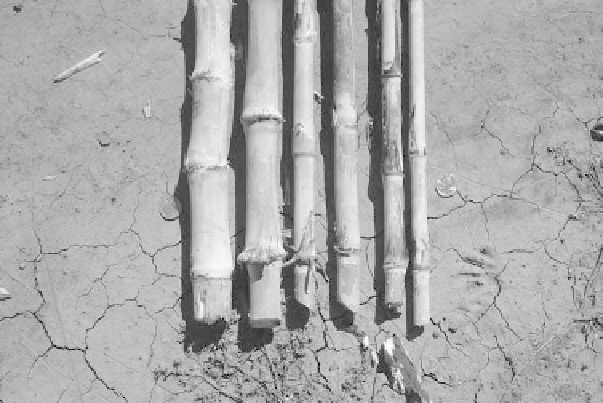Environmental Engineering Reference
In-Depth Information
FIGure 19.2 (see color insert)
Sweet sorghum stalks with different thickness ranges from 15 to 45 mm.
occur, with higher percentages taking place from more open-headed panicles (House et al. 1995).
Compared with the other two major spring planted crops, maize (
Zea mays
)
and soybean
(
Glycine
max
)
,
sorghum has the smallest seed (Vanderlip 1993). Sorghum kernels are generally spherical and
range in
weight from 20 to 30 mg (Hoseney 1994) and can be colored white, cream, pink, yellow,
red, buff, brown, and reddish brown (Bennett et al. 1990). The kernels are covered by glumes, which
can be black, red, brown, or straw. Most are colored. The sorghum kernel is made up of three major
anatomical parts—the pericarp, germ, and endosperm—and each generally accounts for roughly
6, 10, and 84% of the kernel, respectively (Rooney and Serna-Saldivar 2000). The pericarp protects
the kernel and is composed mostly of fiber; the endosperm is a major contributor to the kernel's
protein (80%), starch (94%), and 50-75% of B-complex vitamins; and the germ contains over 68%
of the total mineral matter and 75% of the oil in the whole kernel (FAO 1995).
Sorghum leaves are broad and coarse, similar in shape to those of corn but shorter and wider.
The blades of the leaves are glabrous and waxy. Sheaths encircle the culm and have overlapping
margins. The panicle is erect, sometimes recurved, and is usually compact in most grain sorghums
and more open in forage types. Prop roots may grow from culm nodes, and there is a bud at each
node from which a tiller may grow. The seeds are white, yellow, red, or brown and are covered by
glumes that may or may not be removed by threshing. It has a spikelet that contains two flowers,
only one of which is usually fertile and sets a seed. When threshed, the seed separates from the
floral bracts as in wheat, and the panicle has up to 6000 spikelets. The kernels are small with a round
to conical shape. Seeds number at 25,000-61,740 per kilogram. Sorghum is most commonly red and
hard when ripe, and it is usually dried after harvesting.
19.2.4 a
daptation
Temperature, day length, and water needs are three elements that affect sorghum adaptation
and growth. Sorghum has the ability to produce a crop in areas with marginal rainfall and high
temperatures, where other cereal grains often fail (Cothren et al. 2000), and is found from 40°S
to 45° north latitude (Maunder 2002). Sorghum is more tolerant to high temperature (>38°C) and
drought than most major agronomic crops. Sorghum is a warm-region crop that requires warm
temperature for germination and growth. The optimum germination temperature is between 20°C
and 25°C. Temperatures below freezing may kill the plants depending on stage of development.
At early seedling stage (1-3 weeks), plants could recover after a short exposure to temperature

